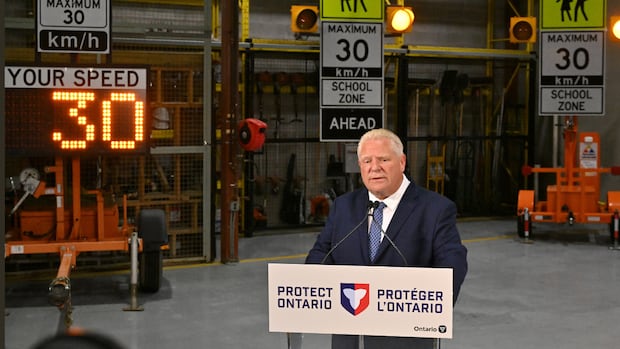Speed cameras work, London council says in push back to Ford's planned province-wide ban

London city council is reiterating its strong support for municipal speed cameras, pushing back against comments Premier Doug Ford has made about the provincial program he has pledged to scrap.
During a council meeting Tuesday, councillors voted unanimously to amend and endorse an Association of Municipalities of Ontario (AMO) resolution calling on the province to work with municipalities, and create a “strengthened and standardized provincial framework” to support speed camera programs.
London has seven speed cameras, also known as automated speed enforcement, which are rotated through different school zones where speeding is an issue.
“I think this is a responsible resolution to support. I think there's discussions to be had. I think there's ways to meet the province in the middle on some of these things,” Deputy Mayor Shawn Lewis told the meeting.
“If they want to dictate that all the revenue goes back into road safety programs, well, we're already doing that. I think that's a good best practice to adopt province-wide.”
The Ford government passed legislation in 2019 allowing municipalities to deploy speed cameras, but late last month said legislation would be tabled to prohibit their use, calling them ineffectual and a “cash grab.”
Despite pushback from the opposition, municipalities, school boards, and police chiefs, Ford has doubled down, saying he believes traffic-calming measures, including speed bumps and roundabouts, are more effective. The province will establish a new fund to help municipalities with such measures, he said.
Municipalities with existing school zone speed cameras will also be required to install large signs with flashing lights.

Ford’s claims are contradicted by the findings of a recent study from SickKids and Toronto Metropolitan University. London’s own data shows areas with speed cameras see an average speed reduction of five to seven km/h, according to city staff.
“If you want to continue making it a cash grab and not looking at alternatives, we have an alternative to put infrastructure in,” Ford said last week. “But folks, they don't want to do that. They want to continue to collect hundreds of millions of dollars and continue speeding.”
Staff say London’s program is revenue-neutral, with money generated put back into the program. Last year, nearly $487,000 was collected in fines, with $381,688 put back into the program. Any surplus is put toward road safety initiatives, like pedestrian crossings.
“Speeders — not taxpayers — pay the cost,” the resolution passed by council on Tuesday reads in part, a message echoed by Lewis during the meeting.
“A ticket for speeding is not a cash grab. It's not a tax grab. If you don't want to pay it, don't speed in a school zone. It’s just that simple,” Lewis said.
Several city councillors said speeding was one of, if not the top issue they hear about from constituents, particularly when it comes to areas around schools and parks.
“Safety in our neighborhoods is one of ... the most emails I get as a city councillor, even for the past 11 years,” said Ward 9 Coun. Anna Hopkins. CBC London has previously reported on constituents’ push for safety upgrades to a stretch of Longwoods Road where a young boy was struck and killed in December.
“The community I represent is very vigilant and is very concerned about safety in their neighborhoods.”
The passed resolution notes that most Ontario drivers support speed cameras, and that they free up police resources.
Should speed cameras go away, Ward 12 Coun. Elizabeth Peloza said the city would have to find new money to pay for the road safety improvements, currently paid for with speed camera surplus.
“If they still want enforcement, there's going to be increased enforcement costs for police across the board, as every ... ward councillor will want some help in their wards,” she said.
Mayor Josh Morgan admitted he wasn’t sure whether the province would be willing to engage in further discussions, or whether they would be willing to make changes to the program.
Regardless, he says it’s the responsibility of motorists to follow the speed limit.
“All you have to do is just walk in front of one of the schools during drop off and pick up and see the amount of kids and parents … and realize the responsible thing to do is to just slow down in school zones,” he said.
“I hope the program is retained for those who don't listen to that, but I think we can all take it upon ourselves to just drive responsibly, particularly in areas where children are involved.”
A copy of Tuesday’s resolution will be sent to Ford and to the ministers responsible for transportation, and municipal affairs and housing.
cbc.ca





